Emerging trends in marketing.
27 Pages8342 Words31 Views
Added on 2022-07-21
Emerging trends in marketing.
Added on 2022-07-21
ShareRelated Documents
Emerging trends in marketing
- Digital marketing
- Virtual and Augmented Reality in marketing
- AI in marketing
- Network marketing
- Affiliate marketing
- Marketing analytics
- Social marketing
5.1 Digital marketing
Digital marketing is defined as a marketing approach that primarily relies on the internet to
connect with the target audience through various digital media channels and platforms.
Digital marketing is an all-encompassing term that consists of digital channels, such as content
marketing, SEO, email marketing, social media marketing, mobile marketing and so on, to create
elaborate strategies to reach and connect with prospects and customers.
Types of Digital Marketing Channels
1. Website: The website is often the home to the digital marketing efforts. Brands and organizations
use websites to host content while using other mediums to distribute it. Most of the digital marketing
activities will link back to the website, where an action is expected to take place, and the conversions
are tracked. For example, the download of a file, booking of a product or a service, and so on.
2. Content Marketing: Content creation is the spine of the entire digital marketing strategy. Whether
there documented content marketing strategy or not, creating content to inform, entertain, inspire, or
persuade the buyers through other channels. Some of the most common formats of content include text
(blog posts), videos, images, infographics, podcasts, slide decks, and ebooks.
3. Search Engine Optimization (SEO): SEO acts as a jetpack for the content marketing
efforts. SEO consists of on-page and off-page activities to boost the website’s visibility in search
engine result pages (SERPs) for the preferred keywords. Earlier, SEO was primarily text-based, but in
- Digital marketing
- Virtual and Augmented Reality in marketing
- AI in marketing
- Network marketing
- Affiliate marketing
- Marketing analytics
- Social marketing
5.1 Digital marketing
Digital marketing is defined as a marketing approach that primarily relies on the internet to
connect with the target audience through various digital media channels and platforms.
Digital marketing is an all-encompassing term that consists of digital channels, such as content
marketing, SEO, email marketing, social media marketing, mobile marketing and so on, to create
elaborate strategies to reach and connect with prospects and customers.
Types of Digital Marketing Channels
1. Website: The website is often the home to the digital marketing efforts. Brands and organizations
use websites to host content while using other mediums to distribute it. Most of the digital marketing
activities will link back to the website, where an action is expected to take place, and the conversions
are tracked. For example, the download of a file, booking of a product or a service, and so on.
2. Content Marketing: Content creation is the spine of the entire digital marketing strategy. Whether
there documented content marketing strategy or not, creating content to inform, entertain, inspire, or
persuade the buyers through other channels. Some of the most common formats of content include text
(blog posts), videos, images, infographics, podcasts, slide decks, and ebooks.
3. Search Engine Optimization (SEO): SEO acts as a jetpack for the content marketing
efforts. SEO consists of on-page and off-page activities to boost the website’s visibility in search
engine result pages (SERPs) for the preferred keywords. Earlier, SEO was primarily text-based, but in
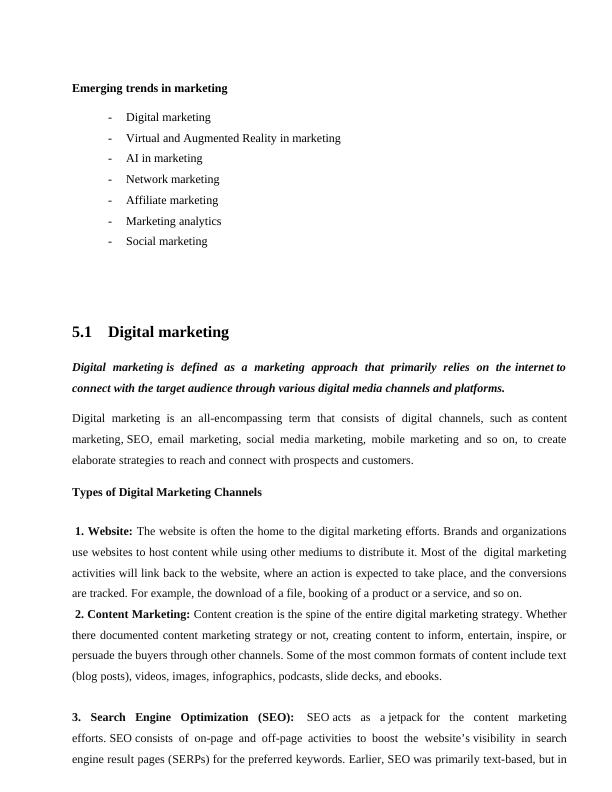
recent years voice search has gained prominence as well, which is why SEO activities need to have a
conversational approach.
4. Digital Advertising:
Digital advertising is an umbrella term for various online advertising strategies. The typical
pricing/bidding strategies for digital advertising are cost-per-click (CPC) and cost-per-mille (CPM),
i.e., per thousand impressions. Common formats of digital advertising are search engine marketing
(SEM), display advertising, native advertising, social media advertising, and programmatic
advertising.
5. Email Marketing
Email marketing is the process of maintaining a database of cold and warm contacts and sending
them email alerts about brand, products and services. It is an effective channel to communicate with
audience on an ongoing basis. Email marketing is useful to build subscriber base, onboard new
customers, retain existing ones, promote discounts and offers, and distribute content.
6. Social Media Marketing
Social media marketing ensure that it is present on the platforms where users are spending the most
time on. These include Facebook, Twitter, LinkedIn, Snapchat, and Instagram, where they can
distribute content through both – organic and paid channels. Social media has also played a vital role
in propagating video marketing and the ephemeral content wave. It enables two-way communication
and the fans and followers can interact with the content through likes, comments, direct messages, or
by posting on the official pages.
7. Affiliate Marketing
The concept of affiliate marketing is similar to commission-based sales. Organizations provide
custom links to their affiliates. Affiliates earn a specific cut/commission every time someone buys
through their custom link. Influence marketing could be considered a modern and evolved spin-off of
affiliate marketing.
8. Mobile Marketing: The number of smartphone users across the world is expected to grow to 3.5
billion in 2020. To bank on this opportunity, brands connect with their users on
their smartphones through mobile apps, emails, mobile-friendly websites, and social media. By
connecting with users on the go, brands have been able to optimize their marketing strategies and send
timely messages.
9. Online PR:Online Public Relations is a type of earned media. This is when a member of the press
(journalist or online publication) mentions the brand through their stories, interviews, and so on.
Product reviews by customers and bloggers and Influencers mentioning the brand or products whether
paid or organic also contribute to the online PR.
conversational approach.
4. Digital Advertising:
Digital advertising is an umbrella term for various online advertising strategies. The typical
pricing/bidding strategies for digital advertising are cost-per-click (CPC) and cost-per-mille (CPM),
i.e., per thousand impressions. Common formats of digital advertising are search engine marketing
(SEM), display advertising, native advertising, social media advertising, and programmatic
advertising.
5. Email Marketing
Email marketing is the process of maintaining a database of cold and warm contacts and sending
them email alerts about brand, products and services. It is an effective channel to communicate with
audience on an ongoing basis. Email marketing is useful to build subscriber base, onboard new
customers, retain existing ones, promote discounts and offers, and distribute content.
6. Social Media Marketing
Social media marketing ensure that it is present on the platforms where users are spending the most
time on. These include Facebook, Twitter, LinkedIn, Snapchat, and Instagram, where they can
distribute content through both – organic and paid channels. Social media has also played a vital role
in propagating video marketing and the ephemeral content wave. It enables two-way communication
and the fans and followers can interact with the content through likes, comments, direct messages, or
by posting on the official pages.
7. Affiliate Marketing
The concept of affiliate marketing is similar to commission-based sales. Organizations provide
custom links to their affiliates. Affiliates earn a specific cut/commission every time someone buys
through their custom link. Influence marketing could be considered a modern and evolved spin-off of
affiliate marketing.
8. Mobile Marketing: The number of smartphone users across the world is expected to grow to 3.5
billion in 2020. To bank on this opportunity, brands connect with their users on
their smartphones through mobile apps, emails, mobile-friendly websites, and social media. By
connecting with users on the go, brands have been able to optimize their marketing strategies and send
timely messages.
9. Online PR:Online Public Relations is a type of earned media. This is when a member of the press
(journalist or online publication) mentions the brand through their stories, interviews, and so on.
Product reviews by customers and bloggers and Influencers mentioning the brand or products whether
paid or organic also contribute to the online PR.
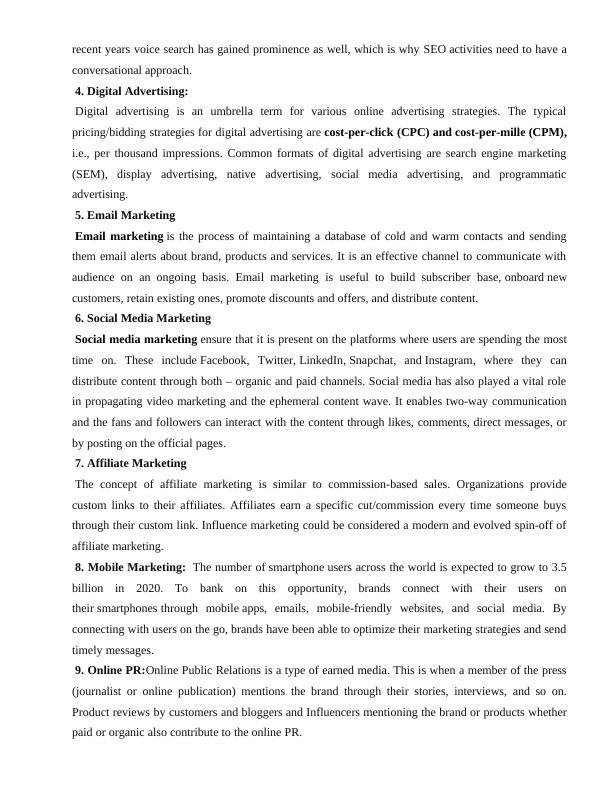
10. Conversational AI: The rise of technologies such as artificial intelligence (AI) and machine
learning (ML) have paved the way for more evolved marketing strategies such as conversational AI.
As the adoption of voice search, chatbots, and digital assistants becomes prevalent, conversational AI
becomes vital to digital marketing.
11. Web Analytics: Web analytics is the practice of collecting, measuring, analyzing, and reporting
data. This is commonly tracked through Google Analytics, but websites could also build their
analytical tools. The data collected could be quantitative or qualitative. Web analytics helps marketers
understand the sources of traffic, what’s working and what the return on investments (ROI) is not, and
how they can enhance their digital marketing efforts.
Importance of Digital Marketing for Small and Large Businesses
Now that we have understood the scope of digital marketing in India, let us look into why it is
important for small and large-sized businesses. The focus for small businesses is brand awareness and
development.
1. Cost-Effective: Digital marketing efforts require barely any initial investment. This is great for
small businesses. Most digital marketing tools offer basic features free of cost. It is up to the
businesses to make the best use of them. Check out the types of digital marketing tools.
2. High Reach : With digital marketing, the reach is global. Hence, can take orders for product or
service from all over the world and it need not be limited to one area. And when the firm goes global,
it can still niche the audience to selected individuals. Thus, it’s a win-win.
3. Brand Awareness
If a customer has no awareness of the brand then he cannot make a conversion. To tackle this, brand
visibility is extremely important. With pay-per-click and other kinds of paid promotions, it can really
attract customers to the small business. Mostly recommended paltforms are Facebook and Instagram
Ads online course to understand some more.
4. Building a Customer Base: The challenge with small businesses is that one needs to build a
customer base. This is based on building a rapport with a strong customer relationship. With CRM
tools such as HubSpot and Oracle, can manage this easily.
The challenges for big businesses are slightly different. They need to retain existing business and
focus on brand reputation, client retention and on the growth of the business.
5. Brand Image
learning (ML) have paved the way for more evolved marketing strategies such as conversational AI.
As the adoption of voice search, chatbots, and digital assistants becomes prevalent, conversational AI
becomes vital to digital marketing.
11. Web Analytics: Web analytics is the practice of collecting, measuring, analyzing, and reporting
data. This is commonly tracked through Google Analytics, but websites could also build their
analytical tools. The data collected could be quantitative or qualitative. Web analytics helps marketers
understand the sources of traffic, what’s working and what the return on investments (ROI) is not, and
how they can enhance their digital marketing efforts.
Importance of Digital Marketing for Small and Large Businesses
Now that we have understood the scope of digital marketing in India, let us look into why it is
important for small and large-sized businesses. The focus for small businesses is brand awareness and
development.
1. Cost-Effective: Digital marketing efforts require barely any initial investment. This is great for
small businesses. Most digital marketing tools offer basic features free of cost. It is up to the
businesses to make the best use of them. Check out the types of digital marketing tools.
2. High Reach : With digital marketing, the reach is global. Hence, can take orders for product or
service from all over the world and it need not be limited to one area. And when the firm goes global,
it can still niche the audience to selected individuals. Thus, it’s a win-win.
3. Brand Awareness
If a customer has no awareness of the brand then he cannot make a conversion. To tackle this, brand
visibility is extremely important. With pay-per-click and other kinds of paid promotions, it can really
attract customers to the small business. Mostly recommended paltforms are Facebook and Instagram
Ads online course to understand some more.
4. Building a Customer Base: The challenge with small businesses is that one needs to build a
customer base. This is based on building a rapport with a strong customer relationship. With CRM
tools such as HubSpot and Oracle, can manage this easily.
The challenges for big businesses are slightly different. They need to retain existing business and
focus on brand reputation, client retention and on the growth of the business.
5. Brand Image
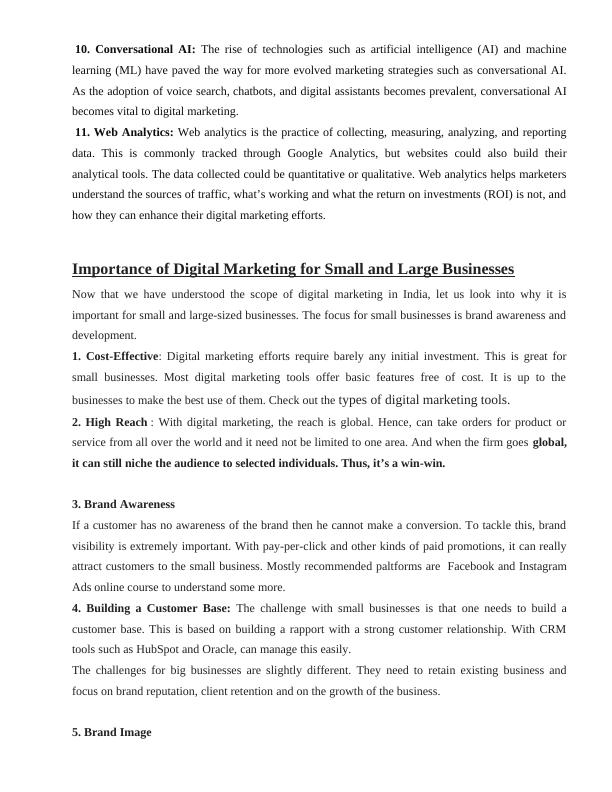
An established company’s image is everything. The right campaign strategies can make or break a
company’s brand image. Through digital marketing, effective campaigns can be designed and the
scope fixing any glitches immediately is there.
6. Measurable Results
With digital marketing, big companies can have real-time measurable results. With this, they can
analyze the effectiveness of the campaign and accordingly formulate strategies. Today, the
significance of analyzing data is very important to evaluate the effectiveness and success of the
campaigns.
7. Increase in ROI
Companies can increase their revenue with digital media by investing in ads and thus, increasing
conversions. The investment in digital media is much lesser than traditional media and the returns are
also higher. The firm can run ads on certain digital platforms for as low price.
8. Retaining Loyal Customers
The main goal of digital marketing for big businesses apart from increasing their business is ensuring
that their customer base is loyal and satisfied.
5.2 Virtual and Augmented Reality in marketing
Virtual Reality creates a digital environment that replaces the user’s real-world environment. Virtual
Reality is primarily used in gaming and entertainment applications. Augmented Reality overlays
digitally-created content into a user’s real-world environment. For instance, Augmented Reality can be
used to project sales and inventory data onto products on store shelves.
In recent times, Augmented Reality and Virtual Reality market coming together to impact businesses
and enterprises. Most of the businesses, nowadays, have transformed into digital Augmented Reality
and Virtual reality, customers find it convenient to use digitized products. Reciprocating to this rise in
digitalization and more customers getting engaged in online activities, retailers are looking for ways to
leverage their digital presence.
Implicit learning and development is one of the domains where Augmented Reality and Virtual
Reality enabled products and services which are gaining traction among the user segments. Other
industries that will experience traction in the Augmented Reality and Virtual Reality space are
aerospace, oil and gas and heavy machinery, where on-the-job training is conventionally difficult or
company’s brand image. Through digital marketing, effective campaigns can be designed and the
scope fixing any glitches immediately is there.
6. Measurable Results
With digital marketing, big companies can have real-time measurable results. With this, they can
analyze the effectiveness of the campaign and accordingly formulate strategies. Today, the
significance of analyzing data is very important to evaluate the effectiveness and success of the
campaigns.
7. Increase in ROI
Companies can increase their revenue with digital media by investing in ads and thus, increasing
conversions. The investment in digital media is much lesser than traditional media and the returns are
also higher. The firm can run ads on certain digital platforms for as low price.
8. Retaining Loyal Customers
The main goal of digital marketing for big businesses apart from increasing their business is ensuring
that their customer base is loyal and satisfied.
5.2 Virtual and Augmented Reality in marketing
Virtual Reality creates a digital environment that replaces the user’s real-world environment. Virtual
Reality is primarily used in gaming and entertainment applications. Augmented Reality overlays
digitally-created content into a user’s real-world environment. For instance, Augmented Reality can be
used to project sales and inventory data onto products on store shelves.
In recent times, Augmented Reality and Virtual Reality market coming together to impact businesses
and enterprises. Most of the businesses, nowadays, have transformed into digital Augmented Reality
and Virtual reality, customers find it convenient to use digitized products. Reciprocating to this rise in
digitalization and more customers getting engaged in online activities, retailers are looking for ways to
leverage their digital presence.
Implicit learning and development is one of the domains where Augmented Reality and Virtual
Reality enabled products and services which are gaining traction among the user segments. Other
industries that will experience traction in the Augmented Reality and Virtual Reality space are
aerospace, oil and gas and heavy machinery, where on-the-job training is conventionally difficult or

dangerous but can be transformed to an easier version through augmented reality and virtual reality
solutions.
The advent of 4G and high speed data communications have become key drivers for the adoption of
Augmented Reality and Virtual Reality. Growing demand for Augmented Reality and Virtual Reality
gear among smartphone users, advent of entry-level Virtual Reality headsets in the market and
marketing push by smartphone manufacturers have boosted the Augmented Reality and Virtual
Reality market across the globe
5.3 AI in marketing
Artificial intelligence marketing is a method of leveraging customer data and AI concepts like
machine learning to anticipate your customer’s next move and improve the customer journey.
Core Elements of Artificial Intelligence Marketing
Artificial intelligence marketing solutions offer ways to bridge the gap between data science and
execution. The process of sifting through and analyzing huge dumps of data was once an
insurmountable process and is now not only feasible, but it’s actually easy
solutions.
The advent of 4G and high speed data communications have become key drivers for the adoption of
Augmented Reality and Virtual Reality. Growing demand for Augmented Reality and Virtual Reality
gear among smartphone users, advent of entry-level Virtual Reality headsets in the market and
marketing push by smartphone manufacturers have boosted the Augmented Reality and Virtual
Reality market across the globe
5.3 AI in marketing
Artificial intelligence marketing is a method of leveraging customer data and AI concepts like
machine learning to anticipate your customer’s next move and improve the customer journey.
Core Elements of Artificial Intelligence Marketing
Artificial intelligence marketing solutions offer ways to bridge the gap between data science and
execution. The process of sifting through and analyzing huge dumps of data was once an
insurmountable process and is now not only feasible, but it’s actually easy
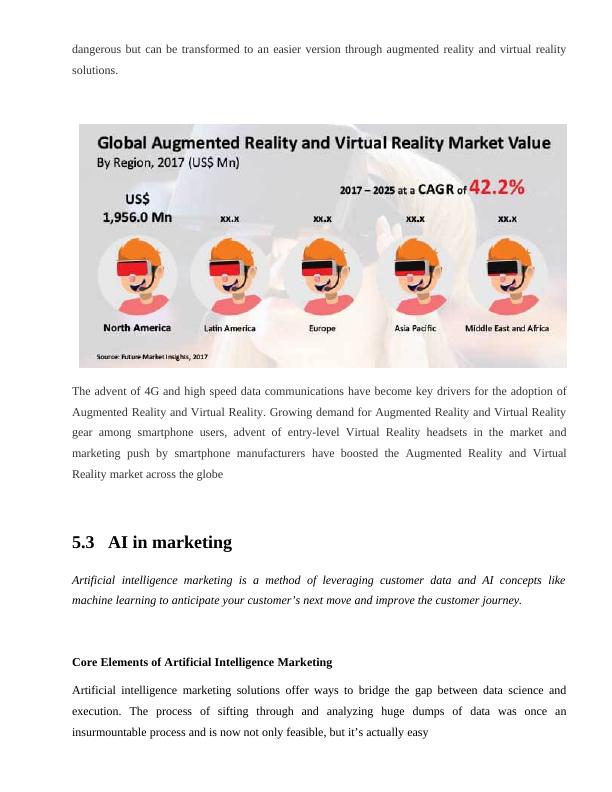
There are a few key elements that make the adoption of AI marketing as important as it is today,
including big data, machine learning, and the right solutions
Big Data
Big data is a pretty straightforward concept. It refers to a marketer’s ability to aggregate and segment
large sets of data with minimal manual work. Marketing teams can then use this data to ensure the
right message is being delivered to the right person at the right time, via their channel of choice.
Machine Learning
Machine learning platforms come in handy when marketers try to make sense of this huge data
repository. They can help identify trends or common occurrences and effectively predict common
insights, responses, and reactions so marketers can understand the root cause and likelihood of certain
actions repeating.
Powerful Solutions
Artificial intelligence marketing solutions truly understand the world in the same way a human would.
This means that the platforms can identify insightful concepts and themes across huge data sets,
incredibly fast. AI solutions also interpret emotion and communication like a human, which makes
these platforms able to understand open form content like social media, natural language,
and email responses.
Core Benefits of Artificial Intelligence Marketing
AI marketing has been gaining more attention among marketers because of the insights it provides.
According to a recent PWC study, 72% view AI as a “business advantage.”AI to influence marketing
outcomes in the upcoming months and years:
1. Increased Marketing ROI
Marketers can leverage AI to transform their marketing campaigns by using data insights and acting
on them in real time. AI platforms are able to make intelligent decisions on how to allocate funds
across channels, analyze high-performing ad placements, and increase value for the marketing
program. Using intelligent budget allocation and spending rules, if used correctly, AI platforms will
improve marketing ROI.
2. Personalized Content Delivery
With AI, marketers can take data and targeting to a whole new level. Audience analytics can go past
the typical demographics level, to understand people on an individual basis. Now, marketers can use
including big data, machine learning, and the right solutions
Big Data
Big data is a pretty straightforward concept. It refers to a marketer’s ability to aggregate and segment
large sets of data with minimal manual work. Marketing teams can then use this data to ensure the
right message is being delivered to the right person at the right time, via their channel of choice.
Machine Learning
Machine learning platforms come in handy when marketers try to make sense of this huge data
repository. They can help identify trends or common occurrences and effectively predict common
insights, responses, and reactions so marketers can understand the root cause and likelihood of certain
actions repeating.
Powerful Solutions
Artificial intelligence marketing solutions truly understand the world in the same way a human would.
This means that the platforms can identify insightful concepts and themes across huge data sets,
incredibly fast. AI solutions also interpret emotion and communication like a human, which makes
these platforms able to understand open form content like social media, natural language,
and email responses.
Core Benefits of Artificial Intelligence Marketing
AI marketing has been gaining more attention among marketers because of the insights it provides.
According to a recent PWC study, 72% view AI as a “business advantage.”AI to influence marketing
outcomes in the upcoming months and years:
1. Increased Marketing ROI
Marketers can leverage AI to transform their marketing campaigns by using data insights and acting
on them in real time. AI platforms are able to make intelligent decisions on how to allocate funds
across channels, analyze high-performing ad placements, and increase value for the marketing
program. Using intelligent budget allocation and spending rules, if used correctly, AI platforms will
improve marketing ROI.
2. Personalized Content Delivery
With AI, marketers can take data and targeting to a whole new level. Audience analytics can go past
the typical demographics level, to understand people on an individual basis. Now, marketers can use
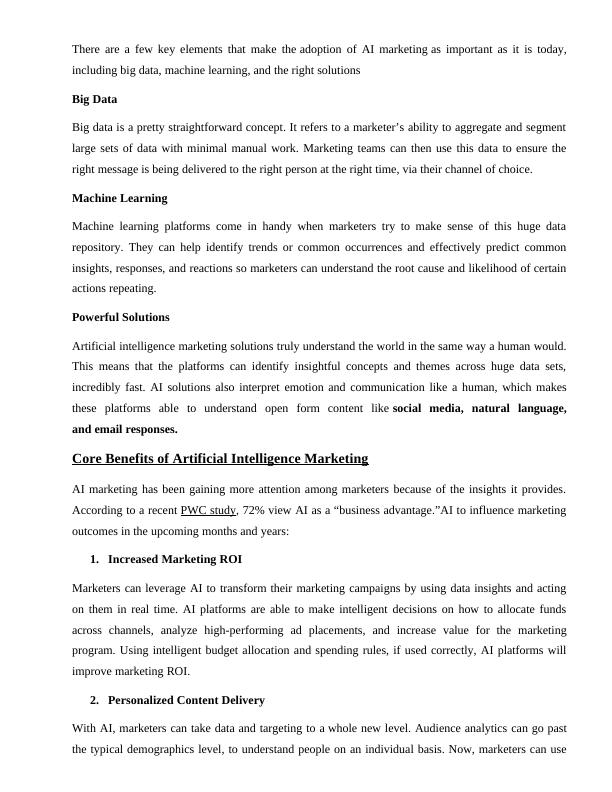
End of preview
Want to access all the pages? Upload your documents or become a member.
Related Documents
Use of Digital Marketing in a Specific Communications Strategylg...
|13
|772
|152
Practical Digital Marketinglg...
|12
|854
|50
Use of Digital Marketing in a Specific Communications Strategylg...
|15
|789
|164
Use of Digital Marketing in a Specific Communications Strategylg...
|13
|737
|494
Practical Digital Marketing for Specific Communications Strategylg...
|13
|1316
|313
An Omni-Channel Digital Marketing Planlg...
|7
|2645
|151
